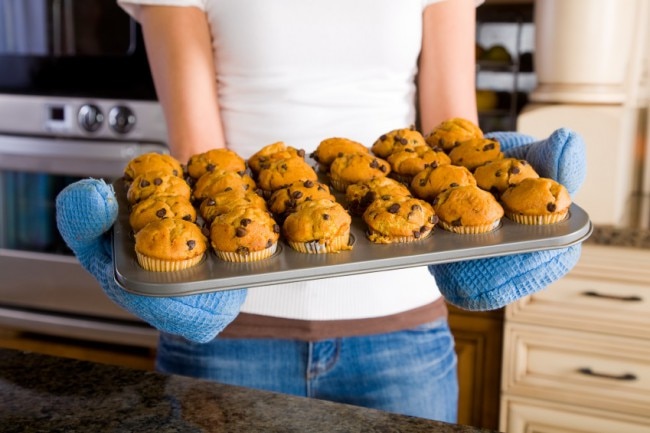Protein powders are the quickest, most convenient way to get muscle-building amino acids after a good workout. But if you’re on the brink of blowing up your blender or chucking that shaker cup, it’s time you sit down and have a cookie. The same protein powder you mix with water or puree with fruit easily transforms into fluffy pancakes, moist muffins and more. Whether you’re creating a recipe from scratch or making over Grandma’s German Chocolate Cake, you’ll want to know these few tips before baking with whey.
Don’t forget the flour
Quality whey protein powder has a nice fine grind, but it doesn’t absorb moisture well enough to be used alone in baked goods. For chewy-gooey brownies and moist cake-like textures, you’ll want to substitute just a third of the flour for 1 scoop of protein powder. To keep the recipe light and nutritious, try using coconut or oat flour (or a combo!). My pantry is always stocked with whole grain rolled oats that I can blend into a floury powder on an as-needed basis.
Moisturize
Just like your skin in the dead of winter, baked protein treats need moisture, moisture, moisture! In addition to fats like oil, eggs or peanut butter, you’ll need to add fresh fruit, unsweetened applesauce, veggie purees, yogurt or cottage cheese. Typically ¼ – ½ cup of a wet ingredient for every cup of dry is enough to keep your desserts from drying out.
Stir with care
You’re used to vigorously shaking your protein powder so it dissolves completely (they don’t call it a shaker cup for nothing). With baking, however, less is so much more. Over-mixing your ingredients can lead to a tough, dense texture, so stir until just combined.
Get greasy
You know those annoying clumps caked to the side of your blender? No matter how fine the protein powder, whey gets sticky. That’s why it’s important to coat your baking sheets and cake pans with nonstick cooking spray. Even paper liners should be sprayed before filling with whey-based muffin or cupcake batter.
Turn down the temp
Even with all that moisture you added, baking with whey can leave you with a dried-out or totally toasted treat. Turning the oven down just 25 degrees from the original recipe’s recommended baking temperature will allow your goodies to cook more evenly. Even still, keep a close eye on the clock. Protein treats don’t typically need as much oven time as their conventional cousins.
Will baking whey cause denaturation?
Short answer: Yes, heating or even mixing protein will denature it. This goes for all types of protein, but it’s completely natural. At the molecular level, the protein changes shape and possibly function, but its nutritional value remains intact.
Long, scientific answer: The structure of protein molecules determines their function(s) in the body. In raw form, these molecules are basically a knotted clump of amino acids, held together by bonds. Heating protein increases the kinetic energy, which creates a lot of movement in the protein molecule. At about 104 degrees F, the protein bonds break from their knotted state (aka denature) to become a linear formation. This means their structure changes, but the actual composition of molecules remains the same. In essence, the amino acids haven’t gone anywhere; they’ve just moved around a bit.
Heating is part of the process to transform whey protein into a powder, so denaturation has technically occurred before you’ve even gotten your hands on the final product. Basically, don’t worry about denaturation. Concern yourself with getting sufficient protein from your diet – whether it be from shakes, cakes or steaks. Remember: our bodies need to consume protein in order to make it – especially those essential amino acids that we can’t produce on our own.

